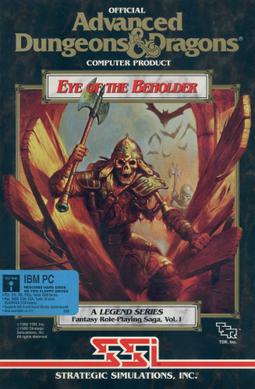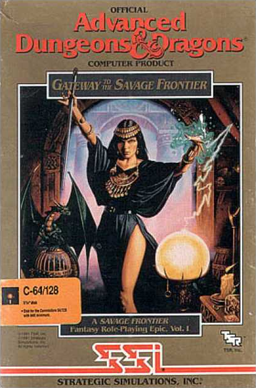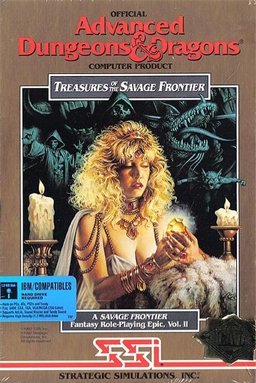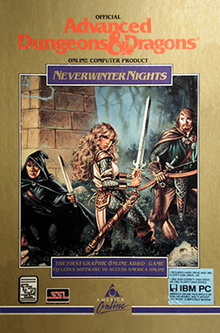A massively multiplayer online role-playing game (MMORPG) is a video game that combines aspects of a role-playing video game and a massively multiplayer online game.
Forgotten Realms is a campaign setting for the Dungeons & Dragons (D&D) fantasy role-playing game. Commonly referred to by players and game designers alike as "The Realms", it was created by game designer Ed Greenwood around 1967 as a setting for his childhood stories. Several years later, Greenwood brought the setting to publication for the D&D game as a series of magazine articles, and the first Realms game products were released in 1987. Role-playing game products have been produced for the setting ever since, as have various licensed products including novels, role-playing video game adaptations, comic books, and the film Dungeons & Dragons: Honor Among Thieves.

Pool of Radiance is a role-playing video game developed and published by Strategic Simulations, Inc (SSI) in 1988. It was the first adaptation of TSR's Advanced Dungeons & Dragons (AD&D) fantasy role-playing game for home computers, becoming the first episode in a four-part series of D&D computer adventure games. The other games in the "Gold Box" series used the game engine pioneered in Pool of Radiance, as did later D&D titles such as the Neverwinter Nights online game. Pool of Radiance takes place in the Forgotten Realms fantasy setting, with the action centered in and around the port city of Phlan.

Neverwinter Nights is a third-person role-playing video game developed by BioWare. Interplay Entertainment was originally set to publish the game, but financial difficulties led to it being taken over by Infogrames, who released the game under their Atari range of titles. It is the first installment in the Neverwinter Nights series and was released for Microsoft Windows on June 18, 2002. BioWare later released a Linux client in June 2003, requiring a purchased copy of the game to play. MacSoft released a Mac OS X port in August 2003.

Eye of the Beholder is a role-playing video game for personal computers and video game consoles developed by Westwood Associates. It was published by Strategic Simulations, Inc. in 1991, for the MS-DOS operating system and later ported to the Amiga, the Sega CD and the SNES. The Sega CD version features a soundtrack composed by Yuzo Koshiro and Motohiro Kawashima. A port to the Atari Lynx handheld was developed by NuFX in 1993, but was not released. In 2002, an adaptation of the same name was developed by Pronto Games for the Game Boy Advance.

Gold Box is a series of role-playing video games produced by SSI from 1988 to 1992. The company acquired a license to produce games based on the Advanced Dungeons & Dragons role-playing game from TSR, Inc. These games shared a common game engine that came to be known as the "Gold Box Engine" after the gold-colored boxes in which most games of the series were sold.

The Shadow of Yserbius, originally published by Sierra On-Line and developed by Joe Ybarra of Ybarra Productions, was the first of three graphical MUDs for the online community. The Shadow of Yserbius and its successors remained online until 1996, when America Online purchased the rights from AT&T for an undisclosed price. AOL soon abandoned The Shadow of Yserbius, which was a competitor to its existing online RPG Neverwinter Nights.
Neverwinter is a fictional city-state in the Forgotten Realms campaign setting for the Dungeons & Dragons fantasy role-playing game. Neverwinter was founded by Lord Halueth Never. It sits on the northwestern coast of the subcontinent of Faerûn.

Neverwinter Nights 2 is a role-playing video game developed by Obsidian Entertainment and published by Atari Interactive. It is the second installment in the Neverwinter Nights series and is the sequel to BioWare's Neverwinter Nights, based on the Dungeons & Dragons fantasy tabletop role-playing game. Neverwinter Nights 2 utilizes an adaptation of the Dungeons & Dragons 3.5 edition rules. Players create player characters to represent themselves in the game, using the same character creation rules as found in the Dungeons & Dragons game. They may gain the assistance of additional party members, and they eventually acquire a keep that can be used as a base of operations. Neverwinter Nights 2 is set in the Forgotten Realms campaign setting—in and around the city of Neverwinter. The story is mostly unrelated to Neverwinter Nights and follows the journey of an orphaned adventurer investigating a group of mysterious artifacts known as "silver shards" and their connection to an ancient, evil spirit known as the King of Shadows.

Stormfront Studios, Inc. was an American video game developer based in San Rafael, California. In 2007, the company had over 50 developers working on two teams, and owned all its proprietary engines, tools, and technology. As of the end of 2007, over fourteen million copies of Stormfront-developed games had been sold. Stormfront closed on March 31, 2008, due to the closure of their publisher at the time, Sierra Entertainment.

Don Daglow is an American video game designer, programmer, and producer. He is best known for being the creator of early games from several different genres, including pioneering simulation game Utopia for Intellivision in 1981, role-playing game Dungeon in 1975, sports games including the first interactive computer baseball game Baseball in 1971, and the first graphical MMORPG, Neverwinter Nights in 1991. He founded long-standing game developer Stormfront Studios in 1988.
Chuck Kroegel is an American video game designer. He was an executive for many years with Strategic Simulations (SSI), and played a role in developing their position as an industry leader in war games and role-playing video games. His career in the video game industry now spans over 30 years.

Gateway to the Savage Frontier (1991) is a Gold BoxDungeons & Dragons computer game developed by Beyond Software and published by SSI for the Commodore 64, PC and Amiga personal computers.

Treasures of the Savage Frontier (1992) is a Gold Box Dungeons & Dragons role-playing video game. It was developed by Beyond Software and published by SSI for the Amiga and DOS.
Cathryn Mataga is a game programmer and founder of independent video game company Junglevision. Under the name William, she wrote Atari 8-bit family games for Synapse Software in the early to mid 1980s, including Shamus, a flip-screen shooter.
The history of massively multiplayer online games spans over thirty years and hundreds of massively multiplayer online games (MMOG) titles. The origin and influence on MMO games stems from MUDs, Dungeons & Dragons (D&D) and earlier social games.

Dark Sun Online: Crimson Sands was an early massively multiplayer online role-playing game (MMORPG) that was developed and published by Strategic Simulations, Inc. in 1996 for Windows 95. Dark Sun Online was based on the licensed Dark Sun campaign setting for the Advanced Dungeons & Dragons tabletop role-playing game. It was one of the first fully graphical MMORPGs.

Neverwinter Nights is a series of video games developed by BioWare and Obsidian Entertainment, based on the Forgotten Realms campaign setting of the Dungeons & Dragons role-playing game. Aside from also being set around the city Neverwinter, it is unrelated to both the 1991 Neverwinter Nights online game and the 2013 online game called Neverwinter.
The 59th Technology and Engineering Emmy Awards was held on January 8, 2008 at the 2008 International Consumer Electronics Show in Las Vegas.












